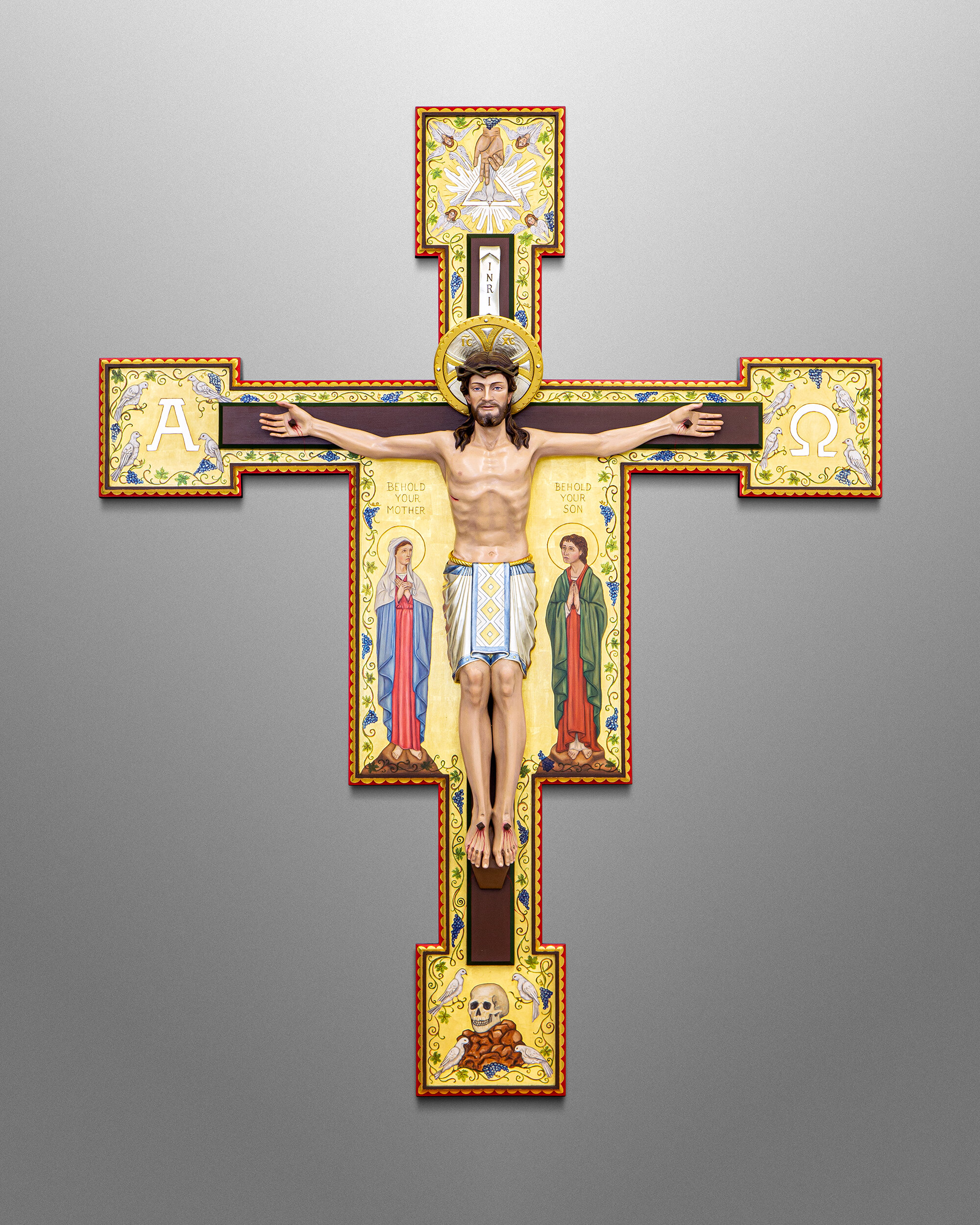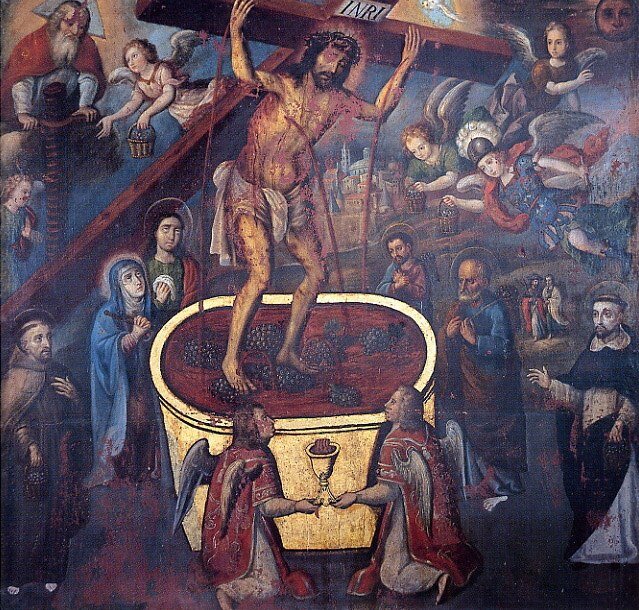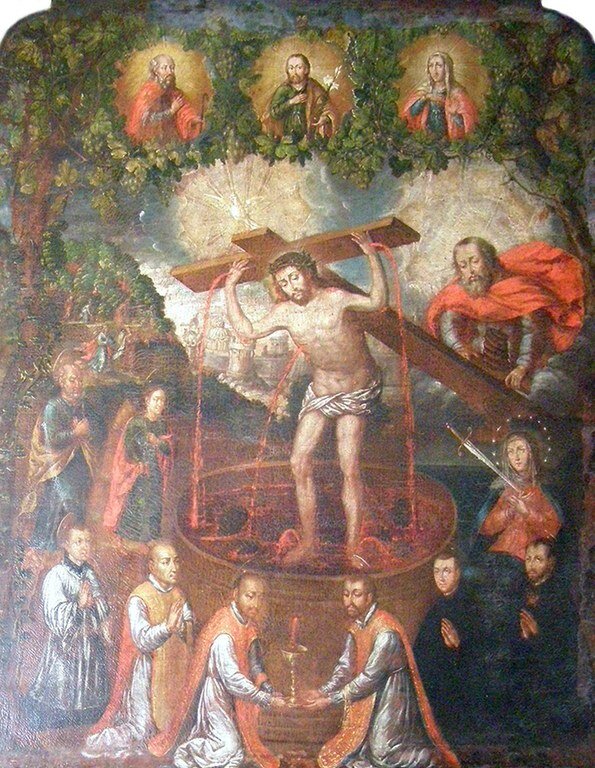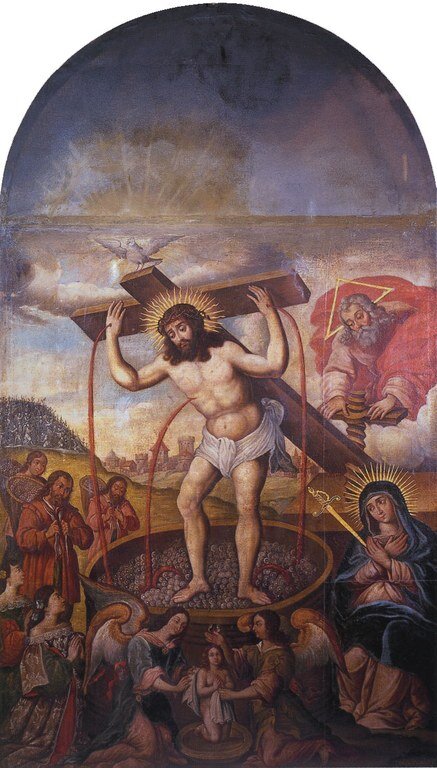Tree of Life, Living Vine Crucifix
The University Catholic Center has a new crucifix that has been anticipated for a number of months during fundraising and its careful production in Germany by renowned woodcarving studio Albl Oberammergau.
by Michael Raia
O Lord our God
You have replanted on our earth the garden lost in Eden, and you have sent a new Gardener to till the soil plowed by the wood of the cross. He who is both the farmer and the seed has watered the earth with his life’s blood, shed for our redemption. Make us grow in his likeness by the power of his word dwelling in our hearts. Through the same Christ our Lord. Amen.
(Magnificat, Morning Prayer – January 11, 2021
Tree of Life, Living Vine Crucifix produced by Albl Oberammergau in collaboration with Studio io for the University Catholic Center in Austin, TX. Courtesy of Albl Oberammergau
The University Catholic Center, which serves the University of Texas at Austin, has a new crucifix that has been anticipated for a number of months during fundraising and its careful production in Germany by renowned woodcarving studio Albl Oberammergau. Designed as an entirely custom commission as a collaborative effort with Studio io, the Tree of Life, Living Vine crucifix simultaneously offers a simple reflection on the rich imagery of Christ’s teaching in the Gospel of John, Chapter 15 and the presence of Mary the Mother of God and the Beloved disciple at the foot of the cross and also rewards further inspection and contemplation with layers of deeper content. The words of John 15 are treasured passages and images for student groups which feature numerous aspects of scriptural typology and liturgical theology, borrowing the best from the eastern and western traditions in sacred art, both ancient and contemporary. The crucifix features a hand-carved and painted corpus in sculptural relief, set on a painted iconographic cross with gold leaf.
Precedents
Given the chapel’s existing niche and prior crucifix, certain elements made sense to retain – a painted cross but more recognizably from within the Church’s gothic/iconographic tradition, such as the beautiful San Damiano, San Gimignano, or Cimabue crucifixes. At the same time, the size argues for larger secondary / tertiary figures, similar to the Rinaldo de Siena’s Crucifix with Mourners, where Mary and John are present on either side of Christ. The presence of these figures both personalizes and universalizes the Paschal mystery and presents it as central to the individual and corporate dimensions of liturgical worship as members in Christ’s Body, the Church. The flatness of the niche and the desire for a more comfortably western crucifix with corpus in relief made recent blended versions of the ancient Italianate examples perfect patterns to follow.
Further inspiration was drawn from the popular early Christian mosaic apse dome precedent at San Clemente in Rome, a reflection on Christ as the fruit of the Tree of Life, and the Living Vine. This precedent served as a primary inspiration for the iteration in the apse dome at St. Mary’s Seminary in Houston, where the 12 apostles are depicted as doves within the branches of the vine. These blending of these images perfectly summarizes the Mystical Body theology of Vatican II that places the Paschal Mystery of Christ firmly at the center of the liturgy and sacraments.
Finally, a careful overview of presentations of Christ as the fruit of the Tree of Life, the Living Vine, and even the cross as the winepress of Christ’s blood spilled for the life of the world provided the opportunity for interplay between Christ’s blood and the subtle vine motif that binds together the other symbolic elements and forms the basis for specific scriptural reflection.
Stylistic Overview
The overall artistic style blends the best aspects of the gothic tradition (itself a balanced blend of iconographic and naturalistic baroque styles) to present Jesus and all of humanity in the space between heaven and earth, a style of pilgrimage. Like the earthly liturgy as both a reality of earthly time and space and one that exists outside of both, this presentation calls to mind the original good of creation that awaits with anticipation the full restoration that is promised in Christ, and the tension between grace and the fallen world within history while we await the return of the Savior. The style is further developed according to the Beuronese movement, including the use of symmetry and order to allow more comfortable naturalistic presentation of the figures in a measured way.
This adjustment avoids the excesses of hyper-realism that denies the supernatural dimension and the triumphal conceit of much of the over-indulgent baroque (not “baroque at its best”) which Benedict XVI criticized as often self-centered rather than Christocentric while keeping the overall appearance grounded in an eschatological iconographic aesthetic that suits well the sacred liturgy in an otherwise image-deprived setting.
The composed appearance and confident, loving gaze of Christ and his posture as both crucified and glorified, as celebrated in the liturgy, are not meant to downplay the historic brutality or minimize the gruesome nature of his crucifixion. Likewise, most popular depictions hardly convey the amount of blood and sheer number of wounds that would have been present on his body. Even less are these a denial of the terrible suffering that our Lord chose to endure for us on the cross. Rather, the iconographic tradition of the Church – as with many popular reliefs in use in the Church today – emphasizes a set of equally important truths about this salvific, Paschal act of Christ: namely, that in the liturgy, his Paschal mystery is made present, and at the same time, Christ is present seated at the right hand of the Father in glory. The oft-repeated axiom of liturgical theologian Dr. David Fagerberg is noted as especially appropriate to guide the discernment of depicting Christ centrally in a church: the liturgical Christ is always the eschatological Christ. As the Catechism of the Catholic Church explains, the suffering, death, Resurrection, and Ascension of Jesus happened within history but, by the power and action of the Holy Spirit in the sacraments, transcend time and also abide within the Church in every age:
“In the liturgy of the Church, it is principally his own Paschal mystery that Christ signifies and makes present. During his earthly life Jesus announced his Paschal mystery by his teaching and anticipated it by his actions. When his Hour comes, he lives out the unique event of history which does not pass away: Jesus dies, is buried, rises from the dead, and is seated at the right hand of the Father "once for all."8 His Paschal mystery is a real event that occurred in our history, but it is unique: all other historical events happen once, and then they pass away, swallowed up in the past. The Paschal mystery of Christ, by contrast, cannot remain only in the past, because by his death he destroyed death, and all that Christ is - all that he did and suffered for all men - participates in the divine eternity, and so transcends all times while being made present in them all. The event of the Cross and Resurrection abides and draws everything toward life.” – CCC 1085
The historic reality of the passion of Christ is made present at the altar as a living and current reality, but at the same time, Christ has also conquered death and is seated now in glory in heaven, a truth made apparent in the deeply liturgical content of Revelation, which describes the Lamb that had been slain as the center of heavenly worship. The entrance into Christ’s death, explained by the Apostle Paul, is precisely what affords the People of God the incredible opportunity to also rise with him – this paradox is celebrated in every Mass and is represented, albeit in a limited way along with every artistic attempt, in way that suspends the liturgy between time and eternity.
This is the mystery of the cross in Catholic liturgy: Christ is the Great High Priest, calling all the baptized, his bride the Church, to share in his priesthood as a holy nation by way of a sacrifice of praise, a joining of hearts and minds to his own sacrifice on the cross made present under the appearance of bread and wine which become his very Body and Blood. He invites us with his own words, recorded in the Johannine Gospel, to make Mary our own Mother and the Mother of our Church, and to be his beloved disciple as he works through his Church to restore that which he created. This sharing is how we participate in his divine life as sharers in his eternal inheritance; we are grafted onto Christ, the True Vine and Tree of Life.
ON THE FACE OF CHRIST
The eyes of Jesus are looking out, not strictly up at the heavens in anticipation of heavenly glory nor solely down at the earth in contemplation of human sin and suffering. Rather, he keeps his eyes fixed in a liminal state; his intense, peaceful gaze is fixed on the present, abiding in all times and inviting everything past and present toward participation in divine eternity by way of the heavenly banquet of the liturgy.
In the liturgy of the Church, it is principally his own Paschal mystery that Christ signifies and makes present. ... His Paschal mystery is a real event that occurred in our history, but it is unique: all other historical events happen once, and then they pass away, swallowed up in the past. The Paschal mystery of Christ, by contrast, cannot remain only in the past, because by his death he destroyed death, and all that Christ is - all that he did and suffered for all men - participates in the divine eternity, and so transcends all times while being made present in them all. The event of the Cross and Resurrection abides and draws everything toward life. (CCC 1085)
While Jesus was fully man and clearly suffered greatly during his six hours on the cross, the liturgical Christ present in the liturgy is no longer actively suffering bodily in heaven in the present. His suffering on Calvary is made present on the altar in an un-bloody manner, inviting the joining of our suffering and sacrifice to his – a sacrifice of praise. The faces of Mary and the Beloved Disciple to whom he gave one another in one of the last of his actions before death remind us that we, at the foot of the cross, bring our sufferings along with those of our Mother Mary, to Jesus. We offer them in every liturgy to join to his Passion made present in the gifts on the altar so that we might also share in the joy of his resurrection and be granted eternal life.
“By the mystery of this water and wine, my we come to share in the divinity of Christ, who humbled himself to share in our humanity.”
The open mouth of Christ on the cross invites several dimensions of reflection. First, it calls to mind the words spoken from the cross, particularly the words 'I thirst," seen as a declaration of love and an invitation to an intimate and personal relationship for every human person he came to save through his salvific act.
“If you knew the gift of God!” The wonder of prayer is revealed beside the well where we come seeking water: there, Christ comes to meet every human being. It is he who first seeks us and asks us for a drink. Jesus thirsts; his asking arises from the depths of God's desire for us. Whether we realize it or not, prayer is the encounter of God's thirst with ours. God thirsts that we may thirst for him. (CCC 2560)
Additionally, this word from the mouth of the Son of God, reminds us that Jesus himself is the Word of God, spoken by the Father to bring about all of creation:
“In the beginning was the Word. . . and the Word was God. . . all things were made through him, and without him was not anything made that was made” (Jn 1:1-3). The New Testament reveals that God created everything by the eternal Word, his beloved Son. In him “all things were created, in heaven and on earth.. . all things were created through him and for him. He is before all things, and in him all things hold together.”130 The Church's faith likewise confesses the creative action of the Holy Spirit, the “giver of life,” “the Creator Spirit” (Veni, Creator Spiritus), the “source of every good” (Col 1:16-10). (CCC 291)
Further Symbolism
Gold Background
The traditional iconographic and later gothic use of gold leaf for the background places the setting of the event in heaven. This important aspect emphasizes the tension between the historical crucifixion and its abiding outside of time as Christ perpetually offers himself in sacrifice to the Father for the Church. The perspective of the figures places them in the middle-ground, intentionally balanced between being too lofty or distant and too casually approachable; this iconographic technique challenges the worshiper to engage in the appropriate way.
Trinitarian Imagery
The divine life of the Trinity, the love from which and for which all things were created and another central theme from the liturgical theology of Vatican II, is represented by the traditional triangle with dove and hand of the Father. While the tradition of the west remains Christo-centric, this device is reminiscent of the similarly described events of Christ’s Baptism and Transfiguration, during which the words of the Father are heard: “Behold, my beloved Son, in whom I am pleased. Listen to him.” Christ’s words to us from his cross in return allow us to turn to Mary the Mother of God and Mother of the Church and the Apostolic Tradition of the Church (John) as our participation in his own life given by the Father as adopted sons and daughters.
Twelve Doves
The twelve white doves are grouped in three of the four arms of the cross, like the current crucifix in the chapel, remind of the four gospels and four living creatures (which have taken up their place as seraphim around the throne at the top of the cross), along with the four marks of the Church. The apostolic mission of the Church, handed on through Sacred Tradition by the apostles, is built on the Gospel of Jesus Christ, and it is from this divine institution that we are invited to the banquet of the Lamb that draws us into the heavenly love song of the Trinity.
Vine and Branches
The vine and branches is a central image from John 15, and one that is also deeply liturgical and at the heart of the Mystical Body theology from the last century. It is the liturgy – grace of the sacraments – that connects us to Christ, that grafts us on as members of his mystical Body to experience the same transfiguration he does as we pass through death and into life. It is appropriate, then, that the vine is red and finds its origin flowing from the wounds in the hands and feet of Christ; the lifeblood of the Church is her sacraments. This vine is living and verdant (green) and bears fruit. The presence of grapes as a ubiquitous liturgical symbol calls to mind the wine used for the liturgy that becomes the Blood of Christ, as well as a number of events such as the Wedding at Cana and the analogy of new wineskins.
Tree of Life
The wood of the cross is at first glance subdued, but surrounded by signs of life rather than death. It bears the fruit of the Tree of Life – Christ, whose flesh is true food and whose blood is life-giving drink. The obvious sign of death, conquered by this saving act of his passion, is that of Adam at the foot of the cross. The artistic tradition of the Church frequently places this here to emphasize the scriptural assertion of Christ as the new Adam, and even a representative parallel in the Gospels between the Garden of Eden and the Garden of Gethsemane and Golgotha. The presence of death is a reminder of the inevitability and necessity of our death – anticipated and represented by baptism – as our entrance into new life in Christ.
Alpha and Omega
“I am the alpha and the omega, the beginning and the end.” Christ’s words and the abbreviation for his name in Greek commonly found in icons, IC XC, squarely place Revelation as the scriptural bookend paired to Genesis – that which was original created as good and marred by sin will be restored by Christ, the same agent and Word through whom it was created in the beginning when God spoke this Word into the darkness and breathed his life into creation. The entirety of salvation history is the covenantal love story of this reintroduction of God to his people by becoming one of them, to rejoin them to relationship, to teach them true worship. The blood flowing from the four wounds in the hands and feet of Christ provide a bridge to the liturgical imagery of the fulfillment of the four rivers flowing from a single source in the Garden of Eden (Gen 2:10) with the description (Rev 21:2) of the heavenly source of the river as the throne of God and the Lamb. All peoples and all nations are called into one in Christ.
Inscription, Cord, Loincloth
The presence of the traditional announcement INRI, Jesus of Nazareth, King of the Jews, reminds of the world’s mockery of a king who would suffer and die in such ignominy. However, this king is something altogether different; he is the new great high priest, because God’s people are to be a priestly nation. Christ’s posture and ornamented loincloth, used in many liturgical crucifixes in the last century, is a subtle emphasis of his priestly office and a reminder that his sacrifice on the cross was the ultimate priestly act. The added presence of the cincture, or cord around his waist, is another reminder of Christ’s office as high priest, representative of the purity of his earthly life as he took on the sins of the world, and the call of celibacy for those ordained to priesthood according to the line of Melchizedek and Aaron.
Signs of Suffering, Signs of Glory
Another duality of the liturgical Christ, offering passage from death into life eternal, is presented in the presence of both the terrible crown of thorns and his radiant halo. Furthermore, Christ’s side has already been pierced, though his eyes remain open. This is a traditional and subtle clue that Christ crucified is made present at the altar, but he is also Christ in glory – his wounds have been transfigured but remain as reminders of his call of discipleship.
Sequence From Dom Guéranger's The Liturgical Year (Friday of the 2nd Week After Easter)
O mighty Cross!
thou drawest the whole world
to thyself, and, with thy two arms,
embracest all mankind.
O lofty Cross!
thou penetratest into the depths below,
and raisest to heaven the captives thou loosest.
On thee, Christ offered the Temple of his Flesh
—which had been built in the number of days
expressed by the four Greek letters composing Adam’s name
—he offered it that it might be destroyed;
but he raised it up again in three days,
that he might save
the four quarters of the world.
O Lamb of the Sovereign Father! That by the Cross takest away the sins of the world!
Grant, that by our growth
in faith, hope, and charity,
we may be able to comprehend,
with all the Saints,
the measure of the Holy Cross;
That having compassion on our neighbours,
and mortifying our flesh,
we may carry the dear Cross,
and be drawn by thee to walk in thy footsteps.
Thus safe and protected in this life,
grant, O divine Judge,
that, by the sign of the holy Cross,
we may be so, when standing before thy tribunal,
And may proclaim aloud to all nations,
‘That the Lord hath reigned from the Wood.’
Amen.
Let our most beautiful
praise magnify
The new victory of the great King
on the Cross.
On the Cross was conquered
the empire of death;
On the Cross was made void
the handwriting
of the sin that was of old;
On the Cross was sacrificed
the Paschal Lamb
for the flock;
On the Cross was the winepress trodden
by him that came from Edom
and Bosra.
It is the antidote
that cures the sting
of the serpent’s wound.
By the Cross is the world
brought back into God's favour;
it was, in Adam, sold by a tree,
and by a tree is now redeemed.
By the Cross,
the last made of creatures
is associated with the morning stars,
and repairs heaven’s losses.
O Cross! thou Tree of Life,
that bearest the Life
and Ransom of the world
—thou art the staff,
bearing upon thee the cluster of grapes
from the vineyards of Engaddi.
Christ is our peace,
who taketh enmities away,
and giveth peace
to them that are afar off,
and to them that are nigh.
The crucifix will be dedicated on Thursday, August 26 by Bishop Joe S. Vásquez.




























